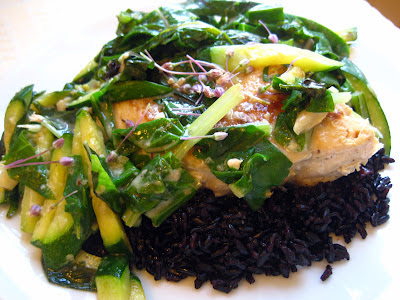This. This is the retort.*
 Make this as a meal in itself, or pair with lemon-mint couscous and carrots braised with toasted cumin seeds and lemon zest.
Make this as a meal in itself, or pair with lemon-mint couscous and carrots braised with toasted cumin seeds and lemon zest. (Inspired by the soup here and the recipes here and here.)
Ingredients
 Olive oil
Olive oil3/4 tsp ground cumin
1 small onion, chopped
1 shallot, chopped
5 cloves garlic, pressed
Scant 1/2 tsp ground cinnamon
3/4 tsp paprika
3/4 tsp Aleppo pepper (or sub 2 pinches cayenne)
1 cup chopped canned tomatoes
2 cans chickpeas, rinsed and drained (or sub 3-4 cups homegrown and precooked)
2 3/4 cups chicken and/or veggie broth
Salt, to taste
2-3 handfuls chopped mild greens (like chard or spinach; or sub 3/4 cup frozen spinach)
Fresh cilantro leaves, for garnish
Heat a soup pot over medium heat. Add a glug of olive oil and allow to heat through. Add the cumin to the oil and let it sizzle for 10 seconds to toast. Stir in the onion, shallot, and another drizzle of olive oil, and saute until the onions soften slightly. Next, add the garlic and a pinch of salt and saute for a minute or two more, turning the heat down a little to keep it from browning.
Add the cinnamon, paprika, and Aleppo pepper, and then stir in the chickpeas. Saute, stirring occasionally, for about 2 minutes, then add the tomato and saute for a minute more. Pour in the broth, cover the pot, and bring to a boil. Turn the heat down to low and simmer gently for 40 minutes.
Adjust salt to taste. Add the greens and simmer for another couple minutes, then turn off the heat. Use an immersion blender to blend just a bit of the soup to thicken it (or ladle one quarter of the soup into a blender, blend till smooth, and return to the pot).
If you have time, let the soup sit, covered, for another 10-15 minutes to allow the flavors to blend.
Serve warm (not boiling hot) and garnish with cilantro.
Serves 3-4.
Pairs in a heavenly way with an Amador County F8 Tempranillo.
*Dear bacon: Don't worry, I still love you.






























